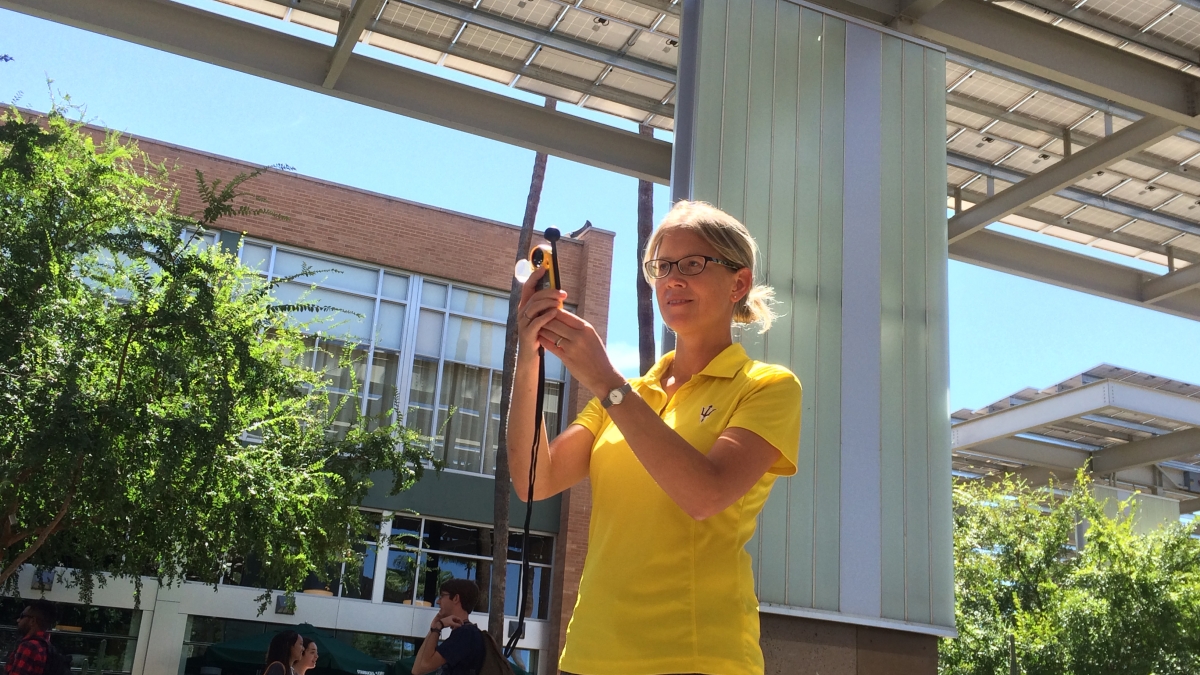Staying cool: The science of shade
Varied environments on campus offer ideal setting for ASU researchers

The varied environments on ASU's Tempe campus near the Memorial Union offered researchers an ideal setting to investigate thermal comfort in hot, sunny conditions.
In sunny Arizona, shade is a precious element of the landscape. Pedestrians follow circuitous routes under trees, awnings and shade structures – rewarded by a more comfortable journey.
Recently-published work by four ASU researchers helps pinpoint how people respond to shade in the desert. They asked, “What’s key to feeling comfortable in the desert, and how does shade contribute?”
The findings give insights on how we can develop more desert spaces to be comfortable in hot, sunny conditions.
“Thermal comfort is a very subjective term,” explained Ariane Middel, assistant research professor in the School of Geographical Sciences and Urban Planning. “How comfortable you feel is influenced by environmental factors that you can objectively measure, such as temperature and humidity, but also by personal factors, such as your clothing or how active you are, or how adapted you are to the outdoor conditions.”
To investigate what drives thermal comfort, Middel and her colleagues took advantage of the varied environments on ASU’s Tempe campus in the area near the Memorial Union. On typical days over four seasons – fall, winter, spring, and pre-monsoon summer, they measured weather conditions in five settings – under the large solar canopy in front of the building, and nearby in a sunny, grassy area, a sunny concrete-paved area, and two areas deeply shaded by trees, one grassy and one concrete-paved.
On the same days, they also conducted surveys – collecting over 1000 in all. The surveys asked respondents how comfortable the temperature felt, as well as their temperature preferences, how they felt in general, their familiarity with desert climates, and their activity level just before taking the survey.
Putting together the meteorological and survey data brought some helpful insights.
First, the meteorological measurement that best aligns with people’s feeling of comfort is one called “globe temperature.” Globe temperature measures all the different types of radiation that strike a person from all directions – and globe temperature is the basis for a thermal comfort index called "PET."
“While air temperature only varies by a couple of degrees between shade and sun, PET can vary by 20 degrees between shade and sun in the summer,” Middelsaid. “While weather forecasts in more humid parts of the country focus on the heat index, in hot dry areas like Phoenix, globe temperature is a better predictor of comfort and heat stress.”
The surveys also revealed patterns and differences in how people perceive temperature in Phoenix. Respondents who had lived in Arizona for a longer time were more adapted and felt more comfortable in hot conditions than respondents who had just moved to the area.
On average, the survey respondents felt that temperatures from 66 to 100 F are acceptably comfortable. The temperature where an average of respondents reported feeling neither hot nor cold – called “neutral temperature” – is 83.5 F.
“This is indeed a nice outdoor temperature in Phoenix,” Middel said.
The study results supported the idea that, here in the dry climate of central Arizona, shade is the most important factor in determining what temperature feels comfortable. So how can we increase shade in urban Phoenix?
Managing heat stress with shade
A key finding was that trees and artificial shade – the solar canopy – seemed to be equally efficient in improving perceived thermal comfort.
This means that artificial shade structures might be an excellent option for providing shade – especially in places where trees have a hard time surviving, such as parking lots or bus stops. Artificial shade structures like those built of solar panels have added benefits of producing electricity, and requiring no water.
“Trees have other benefits of course, such as for aesthetics, storm water retention or wildlife habitat. But in areas where these benefits are secondary, man-made shade structures have great potential to improve our public spaces and make desert life more comfortable,” Middel said.
The research described here was published in the International Journal of Biometeorology. Middel’s collaborators in this project were Nancy Selover and Bjoern Hagen, also with ASU’s School of Geographical Sciences and Urban Planning, and Nalini Chhetri, Assistant Director of the School for the Future of Innovation in Society. Nancy Selover is also Arizona’s state climatologist. All four researchers are senior sustainability scientists with the Julie Ann Wrigley Global Institute of Sustainability.
More Science and technology

Advanced packaging the next big thing in semiconductors — and no, we're not talking about boxes
Microchips are hot. The tiny bits of silicon are integral to 21st-century life because they power the smartphones we rely on,…

Securing the wireless spectrum
The number of devices using wireless communications networks for telephone calls, texting, data and more has grown from 336…

New interactive game educates children on heat safety
Ask A Biologist, a long-running K–12 educational outreach effort by the School of Life Sciences at Arizona State University, has…